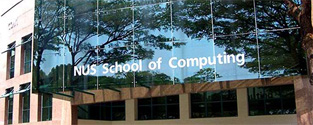1 |
Parallel Speaker: Wilson Teo Way Seng
Title: Synthesis and Characterization of conducting hydrogel adhesive
Supervisor:: Associate Professor Hong Liang, Dr Tay Siok Wei (IMRE)
Department: Department of Chemical and Biomolecular Engineering, Faculty of Engineering
Abstract:
Polyelectrolyte hydrogel constitutes hydrophilic polymer network possessing polymeric backbones with pendant ionic groups. Two types of ion conducting hydrogels, poly(acrylic acid-co-N,N’-methylene bisacrylamide) P(AA-MBAM) and poly(2-hydroxyethyl methacrylate-co-ethylenedimethacrylate) (P(HEMA-EGDMA) were synthesized by free radical polymerization in an aqueous medium containing lithium hydroxide as electrolyte. An investigation into the effect of crosslinking degree of the hydrogels and concentration of electrolyte on the ionic conductivity was carried out by using Direct Current Offset (DCO) voltage and Alternating Current Impedance (ACZ) analysis. The ionic conductivity of the hydrogel was largely affected by the mobility of polymer chains, number of ion-hopping sites of the polar pendant groups, and the occurrence of free volume between the polymer networks. The final stage of the study involved the incorporation of a quaternary ammonium monomer made of diethanolamino-2-hydroxypropyl methacrylate, and 2-bromoethanol into P(HEMA-EGDMA) through copolymerization. This structural modification resulted in higher ionic conductivity according to the measurement of the offset voltage and the frequency-dependent impedance. This finally achieved hydrogel demonstrates the key structural factors required for fast ion transport: water content, sweeping role of the pendant hydrophilic groups, a proper crosslinking degree, and interconnectivity of ion migration channels.
|
2 |
Parallel Speaker: Grace Pohan
Title: Biochemical Modification of Polyvinyl Alcohol Scaffold Mediates Cell Adhesion
Supervisor: Dr Evelyn Yim
Department: Department of Bioengineering, Faculty of Engineering
Abstract:
The mechanical property mismatch between blood vessel and synthetic vascular graft is known to cause thrombus formation and intimal hyperplasia. As an aid to this, drug eluting grafts have been utilized. However, when the drug elution lifespan elapses, the risk remains there.[2] In some cases, the use of drugs may prevent endothelialization on the graft.[2] Studies have shown that endothelialization of synthetic graft is necessary to maintain long term graft patency.[3-6]
Amongst currently studied materials, poly(vinyl alcohol) (PVA) has an advantage in that it has similar mechanical property to that of human artery.[1] In addition, PVA has excellent film-forming, emulsifying and adhesive properties. PVA also has been widely used in food industry as a moisture barrier coating (Joint FAO/WHO Expert Committee on Food Additives) [7] and known to be non-irritant when it is in contact with soft tissue. Considering all these, PVA has become our choice of material. However, despite the superior mechanical property of PVA, graft patency still needs to be improved because occlusion still occurs occasionally in in vivo testing of such graft. As mentioned, one way to improve the patency is by endothelializing PVA. However due to its high hydrophilicity, endothelial cells lining can hardly be established on PVA substrate.
Establishing PVA material which well-mediates cell attachment is the objective in this project. Extracellular matrix proteins are proteins secreted by cells and they mediate cell attachment to a substrate. Therefore, in this study, PVA was modified with extracellular matrix (ECM) proteins including RGDS peptide, fibronectin and heparin. A preliminary result on nanoparticle retainment ability in PVA was also shown. Nanoparticles serve as the protein adsorption point on PVA. The latter is preferable as compared to the bulk modification since less amount of ECM protein will be used, hence less costly, and more consistent results should be produced. In our case, adsorption point is significant because PVA is a hydrogel and therefore simple protein incubation (passive immobilization) will not work.
To sum up, PVA is not only mechano-compatible but also bioinert. Since patency of a PVA graft still needs to be improved, efforts must be taken to achieve adhesive PVA: bulk modification of PVA with proteins and protein immobilization on created adsorption points on PVA. The latter is not yet done due to time constraint. However, preliminary data on this was shown. We hypothesize that biochemical modification helps to improve endothelial cell adhesion to PVA.
References
1. Chaouat, M., et al., Advanced Functional Materials, 2009. 18: p. 2855-2861.
2. Urban, P. and E. De Benedetti, Lancet, 2007. 369: p. 619-621.
3. Meinhart, J.G., et al., Ann. Thorac. Surg., 2001. 71: p. S327-S331.
4. Seifalian, A.M., et al., Artif. Organs, 2002. 26: p. 209-210.
5. Thebaud, N.B., et al., J. Mater. Sci.: Mater. Med., 2007. 18: p. 339-345.
6. Thomas, A.C., G.R. Campbell, and J.H. Campbell, Cardio Vasc. Pathol. , 2003. 12: p. 271-276.
7. Saxena, S.K., 61st JECFA, 2004. |
3 |
Parallel Speaker: Azmall Fraiszudeen
Title: Development of Microfluidic Platform with Nanotopography for 3D micro Muscle tissue Engineering
Supervisor: Professor Leo Hwa Liang
Department: Department of Bioengineering, Faculty of Engineering
Abstract:
Microfluidic devices are enabling platforms that can be useful for studies related to high-throughput screening. These devices are cheap, manipulate fluid flows, minimize costly reagent consumption, and enable high-throughput experimentation in a controlled manner. The microfluidic setup can also enhances mass transfer of nutrients, gases and metabolites, provide a spatiotemporal control of delivery of signaling molecules, and create mechanical strain in the physiological range. We hope to develop a microfluidic platform that incorporates topographical cues which have been shown to be beneficial for engineering of certain cell types, like cardiomyoctyes and skeletal muscle cells and cultivate 3D tissues which mimic physiological conditions. One of applications of this biochip include drug testing as Drug induced cardiotoxicity is a leading cause of drug withdrawal from the US market. Early detection of candidate compounds that are cardiotoxic during the in vitro stage would help reduce the incidence of drug induced cardiotoxicty and also save costs for pharmaceutical companies .
|
4 |
Parallel Speaker: Wong Zheng Hao Samuel
Title: Molecular characterization of gulonolactone oxidase in lungfishes and freshwater stingrays
Supervisor: Professor Ip Yuen Kwong
Department: Department of Biological Sciences, Faculty of Science
Abstract:
This study aimed at the molecular characterization of a gene involved in ascorbic acid synthesis, gulonolactone oxidase (gulo), in five species of extant lungfishes, one from Australia, one from South America and three from Africa, and three species of freshwater stingrays, one from Amazon and two from Asia. Phylogenetic analysis revealed that lungfishes formed a clade separated from other species, and indicated a possible correlation between their positions in the phylogenetic tree and their aestivation behaviour. More importantly, results indicated for the first time that gulo could be expressed in non-kidney organs, such as in the brain and lung of Protopterus aethiopicus and Protopterus dolloi, suggesting that ascorbic acid might have important functions in these organs during aestivation. Results reported herein also showed a sister group relationship between two Asian euryhaline freshwater stingrays, Himantura signifer and Himantura oxyrhynchus indicating their divergence from the stenohaline freshwater Potamotrygon motoro. Unlike the African lungfishes, the expression of gulo in the three stingrays was kidney-specific. Since the mRNA expression of gulo in the kidney of H. signifer was down-regulated after exposure to brackish water, this euryhaline stingray might experience greater osmotic and oxidative stress in freshwater than in brackish water.
|
5 |
Parallel Speaker: Liu Simin
Title: Incorporating Continuum Models of the Solvent into Molecular Energy-based Fragment Molecule Calculations
Supervisor: Associate Professor Bettens, Ryan Philip Anthony
Department: Department of Chemistry, Faculty of Science
Abstract:
In this paper, we are interested in assessing the reliability of a proposed fragmentation method by Bettens and Lee in calculating the energy of large biomolecular systems such as polypeptides. For this purpose, secondary structures β-strand, α-helix and 310- helix of polyglycine systems containing 1 to 13 residues were constructed and subjected to full energy calculation in using the Gaussian03 suite of computer programs at the B3LYP level of theory and 6-31G(d) basis set. All calculations were performed with SCRF=PCM, which uses a continuum model to mimic the solvent (water). Similar parameters were used for the fragmentation approach and the energies from both approaches were compared. The largest magnitude of error derived from the proposed fragmentation approach was found to be within an error margin of 4 mHartrees, 10.9 kJ/mol, and is reasonably acceptable. The energies calculated from both approaches were further used to explore structural stability of secondary structures and hydrogen cooperativity in helices. Finally, linear correlation was employed to study the transitional pathway from the 310-helix to the "-helix in water.
|
6 |
Parallel Speaker: Le Anh Phuong
Title: Expression Analysis of Chondroitin Sulfate Proteoglycan-5 in Phyllodes Tumor
Supervisor: Associate Professor Yip Wai Cheong, George
Department: Department of Anatomy, Faculty of Science
Abstract:
Chondroitin Sulfate Proteoglycan-5 (CSPG5) is a part time proteoglycan predominantly expressed in the central nervous system. It is actively involved in cellular differentiation and brain development. It was also found active in context of tumorigenesis; however, little is known of its role in breast tumor. Breast phyllodes tumor is a rare type of breast lesion that has the potential to become malignant and lethal. Its clinical behavior is difficult to predict. This study attempts to evaluate expression of CSPG5 on 342 phyllodes tumor cases by immunohistochemistry. Statistical tests were implemented to investigate diagnostic and prognostic values of this protein. CSPG5 was found in diffuse stroma and stromal cells. Marked immunohistochemical expression of CSPG5 reflected poor clinical outcome. Correlation between this protein expression and tumor size, age, tumor grade, biochemical factors such as p53, ER, MiB1 suggests that CSPG5 may participate in malignant tumor growth. The findings proposed Chondroitin Sulfate Proteoglycan-5 as an adjunct to existing morphological and biological markers in diagnosis and prognosis of phyllodes tumor.
|
7 |
Parallel Speaker: Zhang Biyan
Title: Investigation of X-linked inhibitor of apoptosis associated factor 1 (XAF1) in breast cancer
Supervisor: Associate Professor Yip Wai Cheong, George
Department: Department of Anatomy, Faculty of Science
Abstract:
Breast cancer is the main cause of female mortality from cancer. Invasive ductal carcinoma (IDC) makes up 80% of breast cancer. Heparan sulphate 6-O sulphotransferases (HS6ST) are responsible for catalyzing 6-O sulphation on heparan sulphate chains, which have been proven to interact with many growth factors resulting in cancer progression. Previous work from HS6ST3 silencing revealed up-regulation of XAF1, a pro-apoptotic protein. This study aims to investigate the expression and role of XAF1 in IDC as well as its association with HS6ST3 at the protein level using immunohistochemistry on clinical IDC samples. Results revealed significant association between HS6ST3 and XAF1. In addition, low XAF1 is shown to correlate with pro-malignant phenotypes such as large tumour size (P=0.035) and high tumour staging (P=0.013). Low XAF1 is also predictive of shortened survival after recurrence with a hazard ratio of 2.364. Taken together, the results suggest that XAF1 plays a tumour-suppressive role in IDC and may serve as a potential prognostic marker for this disease.
|





